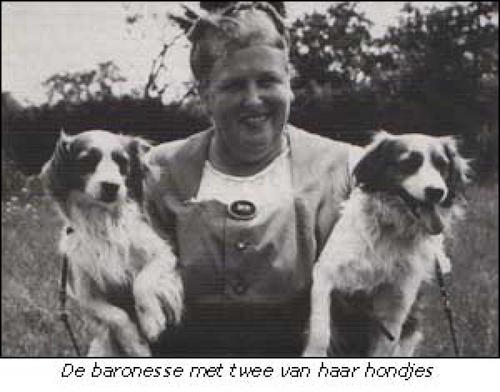
Imagine having a family tree that includes knights, governors, chamberlains and mayors! Such was the pedigree of the Van Hardenbroeks, one of the Netherland’s oldest noble families, a lineage that began in 1332 with Gijsbert van Hardenbroek, Lord of Hardenbroek. From our point of view, the most noble of them all was the Baroness van Hardenbroek van Ammerstol for having saved the Kooikerhondje from extinction.
We don’t really know why the Baroness took a keen interest in the breed. Perhaps an awareness of her country’s history made her cognizant of the Kooiker’s role in averting an assassination attempt on Willem van Oranje (one reason the breed was often called the “Wilhelm the Quiet” dog). Maybe she was a keen observer of art and noticed the breed appearing in famous works such as “The Happy House Companion,” by Jan Steen, or Hendrik Martensz-Sorgh’s, “Lutist. Whatever her motivation, by the time the Baroness took a serious interest, only 25 Kooikerhondjes were left in existence.
As the story goes, sometime in 1939, the Baroness asked a traveling pedlar to keep an eye open for a dog that fit the description she gave him, along with a clipping of coat, and he found one! The trader spotted a dog at a farm in the province of Friesland, a bitch now known as “Tommie.” The farmer didn’t want to give “Tommie,” away, but he did let the Baroness breed her, and “Tommie’s” first litter (or “nest,” as it was called in the Netherlands at the time), made her the foundation matriarch of the Kooikerhondje (the sire of the litter was a Kooiker named “Bennie” (also seen written as “Bobbie”). A second litter was born in 1942, and when “Tommie” became too old for maternity, she was returned to her farm in Friesland. By now, others had become interested in the breed, and more Kooikerhondje litters were born at regular intervals. Some sources report that because the gene pool was so small, other breeds may have been added, but we don’t know this with certainty.
Success was realized in 1946 when the first Kooikerhondjes were given a temporary home, so to speak, in the way of a registry with the national kennel club within the Netherlands, but the baroness and other breeders wanted full official recognition. Between 1967 and 1970, enough dog shows had to take place before the Kooikerhondje got official recognition which finally came in 1971. FCI acceptance came in 1990, though the Baroness would never see this as she died in 1986. Still, her legacy lives on in the more than 14,500 Kooikerhondjes registered in the Netherlands alone.
Image of Baroness van Hardenbroek van Ammerstol found on Pinterest and happily credited upon receipt of information

One thought on “The Baroness and the Kooiker”